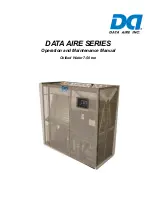
5
1.0 INSTALLATION
There is no intent on the part of Data Aire, Inc. to define local codes or statutes which may
supercede common trade practices. The manufacturer assumes no responsibility for their
interpretation. Consult local building codes and the National Electrical Code for special
installation requirements.
1.1 Room Considerations
Precision air conditioning equipment is designed to control spaces within close tolerances
of temperature and humidity. However, the room must be built with a proper vapor barrier. A film of
polyethylene is often used on walls and ceilings. Walls and floors must also be painted with a
vapor-seal paint. Failure to provide a vapor barrier can compromise space conditions.
Introduction of outside air into the space should be minimized. Outside air in excess of 5% of
the total circulated air volume can have a significant effect on the overall space conditions and
result in poor space control.
1.2 Inspection
This Data Aire unit has been factory run-tested and has gone through a comprehensive
inspection prior to its packaging and shipment to ensure that it arrives in excellent condition. However,
shipping damage can occur and a visual inspection of the outer crating immediately upon delivery
should be performed.
Note any external damage or other transportation damage on the freight carrier’s forms. Inspect
the unit itself for internal damage. A claim should be filed with the shipping company if the equipment
is damaged or incomplete.
Loose items such as remote control panels, disconnect switch handles, spare belts and spare
filters are packed inside the unit. Refer to the yellow shipping tag located on the unit door for
details.
Freight damage claims are the responsibility of the purchaser. Action to recover losses
should be filed immediately. Please notify factory personnel of any claims.
1.3 Rigging
Move the unit in its upright position to the installation site. It is recommended that the unit be
protected from damage to the decorative doors during any storage or moving. Removal of the
decorative doors is easily accomplished and may be done when moving equipment.
The shipping skid should be left in place if the unit is being moved with a forklift. If the unit is
being lifted, use spreader bars to prevent damage to the doors and panels.
The unit has 3/4" holes in the shipping skid to which casters with 3/4" stems can be attached.
This allows easy movement down halls, into elevators and through doorways. If clearance is a






































